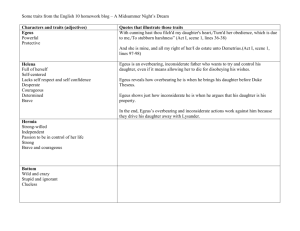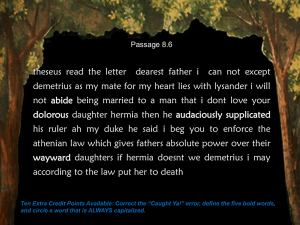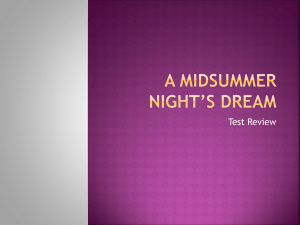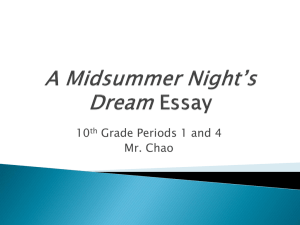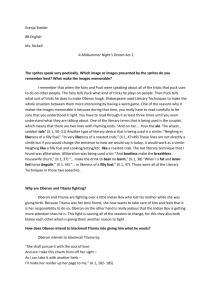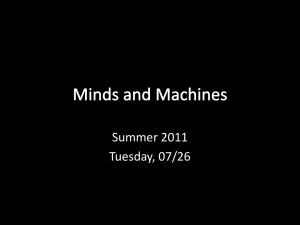Grade 8 Module 2B, Unit 1, Lesson 9
advertisement
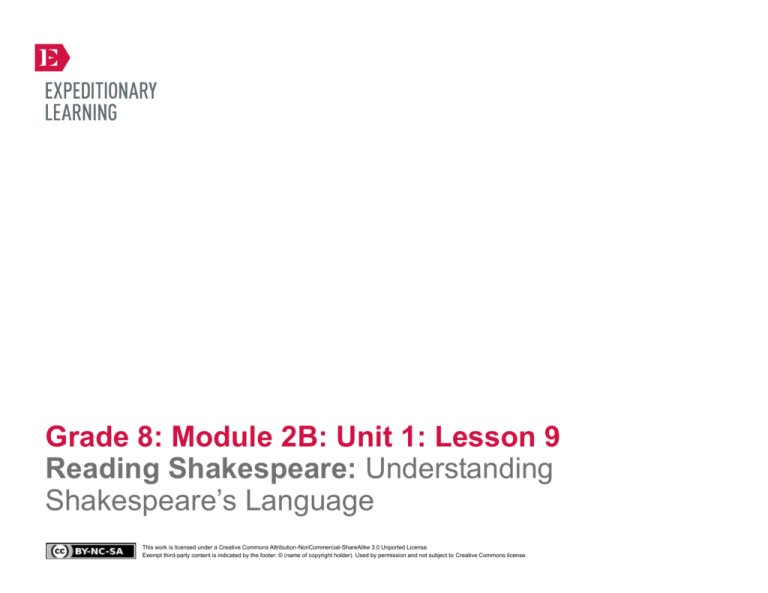
Grade 8: Module 2B: Unit 1: Lesson 9 Reading Shakespeare: Understanding Shakespeare’s Language This work is licensed under a Creative Commons Attribution-NonCommercial-ShareAlike 3.0 Unported License. Exempt third-party content is indicated by the footer: © (name of copyright holder). Used by permission and not subject to Creative Commons license. GRADE 8: MODULE 2B: UNIT 1: LESSON 9 Reading Shakespeare: Understanding Shakespeare’s Language Long-Term Targets Addressed (Based on NYSP12 ELA CCLS) I can analyze how specific dialogue or incidents in a plot propel the action, reveal aspects of a character, or provoke a decision. (RL.8.3) I can determine the meaning of words and phrases in literary text (figurative, connotative, and technical meanings). (RL.8.4) Supporting Learning Targets Ongoing Assessment • I can analyze how specific lines of dialogue in A Midsummer Night’s Dream help the play move forward. • Act 1, Scene 1 Written Conversation note-catcher • I can analyze Shakespeare’s use of language in A Midsummer Night’s Dream. • Lesson 9 structured notes Created by Expeditionary Learning, on behalf of Public Consulting Group, Inc. © Public Consulting Group, Inc., with a perpetual license granted to Expeditionary Learning Outward Bound, Inc. NYS Common Core ELA Curriculum • G8:M2B:U1:L9 • June 2014• 1 GRADE 8: MODULE 2B: UNIT 1: LESSON 9 Reading Shakespeare: Understanding Shakespeare’s Language Agenda Teaching Notes 1. Opening • Having built a bit of confidence in reading Shakespeare’s language and a bit of engagement about the humor in the play (during Lesson 8), students now read the play from the beginning. A. Engaging the Reader: Sharing the Gist (3 minutes) B. Reviewing Learning Targets (2 minutes) 2. Work Time A. Drama Circle: Act 1, Scene 1 (25 minutes) B. Written Conversation: Understanding Shakespeare’s Language (10 minutes) 3. Closing and Assessment A. Tips for Reading Shakespeare (4 minutes) B. Previewing Homework (1 minute) 4. Homework A. Reread 1.1.21–129 and complete the structured notes. • As noted in Lesson 8, throughout this module, much of students’ initial reading of the play will occur during an in-class Drama Circle. Students will read the selected lines twice in class, once all the way through without stopping and a second time with guided teacher questions. • Students then will reread the same scene independently for homework, reinforcing the idea that complex texts often require multiple readings. Today, they read part of Act 1, Scene 1 in a Drama Circle so they can continue building confidence with the text with teacher support. • In a classroom with many struggling readers, consider conducting the initial Drama Circle read-aloud yourself (i.e., reading all the parts) so students can hear the scene read fluently before attempting it. • In order to spend more time closely reading and studying other passages, students will skip certain lines of A Midsummer Night’s Dream. The decision to skip certain lines was made by considering opportunities for students to attend to the character and thematic developments over the course of the text. When students skip a portion of the text, you will provides an oral summary and there will also be a written summary in the structured notes. • In this lesson, students skip a portion of the opening scene between Theseus and Hippolyta, in order to jump right into Egeus’s plea to Theseus for help controlling Hermia. (Consider assigning the omitted scenes to strong readers as extension homework.) • In advance: Copy the Tips for Reading Shakespeare bookmark on cardstock and cut into strips, one per student. • Review: Written Conversation protocol (see Appendix). • Post: Learning targets. Created by Expeditionary Learning, on behalf of Public Consulting Group, Inc. © Public Consulting Group, Inc., with a perpetual license granted to Expeditionary Learning Outward Bound, Inc. NYS Common Core ELA Curriculum • G8:M2B:U1:L9 • June 2014• 2 GRADE 8: MODULE 2B: UNIT 1: LESSON 9 Reading Shakespeare: Understanding Shakespeare’s Language Lesson Vocabulary Materials dialogue; vexation (1.1.23), consent (1.1.26), cunning (1.1.37), beseech (1.1.64), relent (1.1.93) • Play Map (from Lesson 8; one per student) • A Midsummer Night’s Dream (book; one per student) • Act 1, Scene 1 Teacher’s Guide, Part 1 (for teacher reference) • Act 1, Scene 1 Written Conversation note-catcher (one per student) • Tips for Reading Shakespeare handout (one per student) • Tips for Reading Shakespeare bookmark (one per student) • A Midsummer Night’s Dream structured notes, 1.1.21–129 (one per student) • A Midsummer Night’s Dream supported structured notes, 1.1.21–129 (optional, for students needing additional support) • A Midsummer Night’s Dream structured notes teacher’s guide, 1.1.21–129 (for teacher reference) Created by Expeditionary Learning, on behalf of Public Consulting Group, Inc. © Public Consulting Group, Inc., with a perpetual license granted to Expeditionary Learning Outward Bound, Inc. NYS Common Core ELA Curriculum • G8:M2B:U1:L9 • June 2014• 3 GRADE 8: MODULE 2B: UNIT 1: LESSON 9 Reading Shakespeare: Understanding Shakespeare’s Language Meeting Students’ Needs Opening A. Engaging the Reader: Sharing the Gist (3 minutes) • Invite students to sit with their New York City discussion partners. • Have them discuss their gist notes about Act 1, Scene 2 from last night’s homework. • After a minute, cold call a pair to share ideas about the most important plot details from Act 1, Scene 2. Listen for students to remember that this scene featured Bottom and the other workmen discussing the play they will perform at Theseus and Hippolyta’s wedding. They should also recall that Bottom emerges as a comically controlling, but ignorant, character. B. Reviewing Learning Targets (2 minutes) • Read the learning targets aloud as students follow along silently: * “I can analyze how specific lines of dialogue in A Midsummer Night’s Dream help the play move forward.” * “I can analyze Shakespeare’s use of language in A Midsummer Night’s Dream.” • Draw students’ attention to the word dialogue and explain that it refers to a conversation between two or more people in a play. (Consider asking if anyone knows what it is called when just one character speaks in a play, and listen for a volunteer to say “monologue.”) • Tell students that they will begin reading A Midsummer Night’s Dream from the beginning today. Have them take out their Play Maps from the previous lesson to use as a reference throughout class. Created by Expeditionary Learning, on behalf of Public Consulting Group, Inc. © Public Consulting Group, Inc., with a perpetual license granted to Expeditionary Learning Outward Bound, Inc. NYS Common Core ELA Curriculum • G8:M2B:U1:L9 • June 2014• 4 GRADE 8: MODULE 2B: UNIT 1: LESSON 9 Reading Shakespeare: Understanding Shakespeare’s Language Work Time Meeting Students’ Needs A. Drama Circle: Act 1, Scene 1 (25 minutes) • Invite students to set their chairs up in a Drama Circle like they did in Lesson 8. As they do this, distribute a copy of A Midsummer Night’s Dream to each student. • As in Lesson 8, you may want to split the roles up by page (Egeus 1, Egeus 2, etc.) so more students can participate in the Drama Circle. This also allows you to differentiate, as some pages have fewer lines than others. • Ask students what they learned about reading and understanding Shakespeare’s language in the last class. Listen for them to say that Shakespeare wrote using difficult language and style (unfamiliar vocabulary, challenging syntax), but that they can get the gist of the story by reading it more than once. • Explain that students will skip certain parts of this play so they can focus more intensely on other parts. The first part they will skip is the first page of the play. Draw students’ attention back to the Play Map and point out the sentence at the top of the page: “In Athens, all are getting ready for the marriage of Theseus and Hippolyta.” Tell students that A Midsummer Night’s Dream opens with a conversation between Theseus and Hippolyta in which they look forward to their wedding, which is four days away. The setting of this scene is Theseus’s court, or palace. Students will begin reading on the next page, when a character named Egeus enters the palace, hoping to talk to Theseus. Ask: * “Based on what you see on the Play Map, what do you think Egeus wants to talk to Theseus about?” • Give students a moment to look back at the Play Map and think. Then, listen for a volunteer to say that Egeus wants to talk to Theseus about his daughter, Hermia, and who she is going to marry. • Have students turn to page 9. Draw their attention to some of the features of this text: the line numbers in the right-hand margin and the notes on the left-hand page that correspond to those line numbers. Tell students that during a Drama Circle, they should focus on the original script on the right-hand page. • Remind students that in a Drama Circle, a different person reads each role. Assign parts for this scene: Egeus, Theseus, Hermia, Demetrius, and Lysander. • Have students read the scene aloud, starting at the top of page 9 (1.1.21) and ending on page 15 (1.1.129). • After this first read, tell students they will reread the scene to deepen their understanding. This time you will have them pause to answer questions about what they read. Consider switching roles for this second read. • Have students reread the scene aloud. Refer to the Act 1, Scene 1 Teacher’s Guide, Part 1 for detailed notes on guiding students through the scene. Created by Expeditionary Learning, on behalf of Public Consulting Group, Inc. © Public Consulting Group, Inc., with a perpetual license granted to Expeditionary Learning Outward Bound, Inc. • Consider creating a nametag for each character to wear during the Drama Circle to help students keep them clear. • As students are just beginning to build confidence reading Shakespeare aloud, consider playing one of the main roles (Egeus or Theseus) yourself. This will allow them to hear longer chunks of the text read aloud fluently. • Consider appointing several students to act as “interpreters.” When the Drama Circle read-aloud hits a particularly challenging bit of language, the interpreters are charged with referring to the lefthand page for explanatory notes, then reading or paraphrasing those notes for the class. NYS Common Core ELA Curriculum • G8:M2B:U1:L9 • June 2014• 5 GRADE 8: MODULE 2B: UNIT 1: LESSON 9 Reading Shakespeare: Understanding Shakespeare’s Language Meeting Students’ Needs Work Time (continued) B. Written Conversation: Understanding Shakespeare’s Language (10 minutes) • Invite students to sit with their New York City discussion partners again. Explain that students will have a Written Conversation with their partners to analyze some of Shakespeare’s language choices. in this scene. Remind students that in a Written Conversation, they should not speak aloud. • Distribute the Act 1, Scene 1 Written Conversation note-catcher. Tell students to choose which partner will start on Question 1 (on the front of the page) and which partner will start on Question 2 (on the back of the page). • Give them 2 minutes to think and fill in the first column on the note-catcher (“I Say”). • Have students switch papers. Give them 90 seconds for each remaining column on the note-catcher. • Cold call one or two pairs to share their thinking about Question 1. Listen for them to say that Shakespeare might have chosen the phrase “dispose of” to imply that Egeus sees his daughter as his property, not as a full human being. Others might think that he is saying “dispose of” because he is so angry at Hermia that he is trying to make her feel like a piece of garbage. Jot down some notes about this question on the board and have students write them in the “Notes from class discussion” space at the bottom of the page. • Cold call one or two pairs to share their thinking about Question 2. Listen for them to say that Shakespeare might have chosen the word “yoke” to show that Hermia sees marrying Demetrius as an unfair way to control her, making her more like an animal than a human who can make her own choices. Jot down some notes about this question on the board and have students write them in the “Notes from class discussion” space at the bottom of the page. Created by Expeditionary Learning, on behalf of Public Consulting Group, Inc. © Public Consulting Group, Inc., with a perpetual license granted to Expeditionary Learning Outward Bound, Inc. NYS Common Core ELA Curriculum • G8:M2B:U1:L9 • June 2014• 6 GRADE 8: MODULE 2B: UNIT 1: LESSON 9 Reading Shakespeare: Understanding Shakespeare’s Language Meeting Students’ Needs Closing and Assessment A. Tips for Reading Shakespeare (4 minutes) • Tell students to put their Play Maps in a safe place as you distribute the Tips for Reading Shakespeare handout. Have students turn to their discussion partner and partner read the handout aloud. • Distribute the Tips for Reading Shakespeare bookmark and tell students that this bookmark will be a helpful reminder of what they just read on the handout. Encourage students to have this bookmark and the Play Map out when they do their reading homework. B. Previewing Homework (1 minutes) • Remind students that they will be rereading passages from today’s Drama Circle for homework. • Write “1.1.21–129” on the board and show students how to read it: The first number is the act, the second number is the scene, and the other numbers are the lines. In this case, they should reread Act 1, Scene 1, Lines 21–129. Draw students’ attention to the act and scene numbers listed on the top right-hand corner of each page of the play. • If you have time, quiz them on reading this format by challenging them to find the following lines: 1.1.66, 2.1.125, 4.2.32. • Distribute the A Midsummer Night’s Dream structured notes, 1.1.21–129. Homework Meeting Students’ Needs • Reread 1.1.21–129 and complete the structured notes. • Provide struggling learners with the supported structured notes for additional scaffolding as they read the play. Created by Expeditionary Learning, on behalf of Public Consulting Group, Inc. © Public Consulting Group, Inc., with a perpetual license granted to Expeditionary Learning Outward Bound, Inc. NYS Common Core ELA Curriculum • G8:M2B:U1:L9 • June 2014• 7 Grade 8: Module 2B: Unit 1: Lesson 9 Supporting Materials This work is licensed under a Creative Commons Attribution-NonCommercial-ShareAlike 3.0 Unported License. Exempt third-party content is indicated by the footer: © (name of copyright holder). Used by permission and not subject to Creative Commons license. GRADE 8: MODULE 2B: UNIT 1: LESSON 9 Act 1, Scene 1 Teacher’s Guide, Part 1 Use this guide during the second reading in the Drama Circle. As students read the scene aloud, pause to ask questions and discuss the scene. Encourage students to support their answers with evidence from the text whenever possible. Line(s) Quotation Notes, questions, and discussion prompts 1.1.23 “Full of vexation come I” What is vexation? What other words in this sentence can help us figure out what vexation means? Complaint can help us figure out that vexation has something to do with being upset or annoyed. To be “vexed” with someone is to be irritated or displeased. 1.1.25–28 “Stand forth, Demetrius … the bosom of my child.” Who are Hermia, Demetrius, and Lysander? Hermia is Egeus’s daughter (“my child, my daughter Hermia”). Demetrius is the man Egeus wants her to marry (“This man hath my consent to marry her”). Lysander is the man she is in love with (“This man hath bewitched the bosom of my child”). 1.1.29–36 “Thou, thou … unhardened youth.” Egeus is making a list in these lines. What is he listing? Egeus is listing all of the ways Lysander has “bewitched” Hermia’s heart, or tricked her into falling in love with him. Two examples are that he gave her presents and recited poetry to her. 1.1.37-39 “With cunning … stubborn harshness.” Why is Egeus so angry at Lysander? Egeus is angry because he thinks Hermia should obey him (“her obedience (which is due to me)”), but she has disobeyed him by refusing to marry Demetrius. Egeus blames Lysander for Hermia’s rebellion against him. Created by Expeditionary Learning, on behalf of Public Consulting Group, Inc. © Public Consulting Group, Inc., with a perpetual license granted to Expeditionary Learning Outward Bound, Inc. NYS Common Core ELA Curriculum • G8:M2B:U1:L9 • June 2014 • 9 GRADE 8: MODULE 2B: UNIT 1: LESSON 9 Act 1, Scene 1 Teacher’s Guide, Part 1 Line(s) Quotation Notes, questions, and discussion prompts 1.1.39–46 “And, my gracious Duke … in that case.” Egeus is asking for Theseus’s permission. What does he want to be allowed to do? Egeus wants to be allowed to force Hermia to marry Demetrius, and, if she won’t, to kill her. Why does Egeus think he should be allowed to kill his own daughter? His speech implies that there is a law in Athens that says he has that right: “the ancient privilege of Athens,” “that she is mine,” “according to our law.” 1.1.47–59 “What say you, Hermia? … his judgment look.” Created by Expeditionary Learning, on behalf of Public Consulting Group, Inc. © Public Consulting Group, Inc., with a perpetual license granted to Expeditionary Learning Outward Bound, Inc. How does Theseus respond to Egeus’s plea? Theseus tells Hermia she should listen to her father: “To you, your father should be as a god,” “Demetrius is a worthy gentleman,” “Rather your eyes must with his judgment look.” NYS Common Core ELA Curriculum • G8:M2B:U1:L9 • June 2014 • 10 GRADE 8: MODULE 2B: UNIT 1: LESSON 9 Act 1, Scene 1 Teacher’s Guide, Part 1 Line(s) Quotation Notes, questions, and discussion prompts 1.1.60–66 “I do entreat … to wed Demetrius.” What can we tell about Hermia’s character from what she says to Theseus here? Hermia is strong-willed, because she is willing to stand up against someone as powerful as Theseus. She doesn’t want to be disrespectful (“pardon me,” “I beseech your Grace”), but she believes she should have the right to “refuse to wed Demetrius.” She wants to know what will happen to her (“the worst that may befall me”), which shows that she is trying to think rationally about the situation. How might Hermia’s question push the play forward? (In other words, how would the play be different if she just agreed with Egeus?) Asking Theseus what will happen to her if she disobeys Egeus helps push the play forward because it defines a major conflict of the play; it is clear that Hermia is not going to obey Egeus, which will likely lead to further action on Egeus’s part. If Hermia agreed with Egeus, there would be no conflict, and the play could not move forward with any real action. Created by Expeditionary Learning, on behalf of Public Consulting Group, Inc. © Public Consulting Group, Inc., with a perpetual license granted to Expeditionary Learning Outward Bound, Inc. NYS Common Core ELA Curriculum • G8:M2B:U1:L9 • June 2014 • 11 GRADE 8: MODULE 2B: UNIT 1: LESSON 9 Act 1, Scene 1 Teacher’s Guide, Part 1 Line(s) Quotation Notes, questions, and discussion prompts 1.1.67-80 “Either to die … single blessedness.” Theseus gives Hermia three choices: marry Demetrius, die, or what? Theseus says that Hermia could become a nun. “To abjure forever the society of men” refers to the fact that nuns take a vow of celibacy. He also asks her if she can “endure the livery of a nun” and makes several more references to her being celibate and not having children: “to live a barren sister all your life,” “the cold fruitless moon.” Theseus talks about two different kinds of roses at the end of this speech: “the rose distilled,” meaning a rose turned into perfume, and the rose that withers and dies without being picked. Why does Theseus talk about a rose here? What is he comparing a rose to? He is using the rose as a metaphor for young women. He means that young women who marry (are “picked”) are happier than those who do not (who “wither on the thorn”). He is trying to persuade Hermia to marry Demetrius. (Point out explanation on page 10.) Created by Expeditionary Learning, on behalf of Public Consulting Group, Inc. © Public Consulting Group, Inc., with a perpetual license granted to Expeditionary Learning Outward Bound, Inc. NYS Common Core ELA Curriculum • G8:M2B:U1:L9 • June 2014 • 12 GRADE 8: MODULE 2B: UNIT 1: LESSON 9 Act 1, Scene 1 Teacher’s Guide, Part 1 Line(s) Quotation Notes, questions, and discussion prompts 1.1.81–84 “So will I grow … not to give sovereignty.” How does Hermia respond to Theseus’s rose metaphor? Hermia says she would rather be the rose that “withers on the thorn” (“so will I grow, so live, so die”) than lose her virginity (“Ere I will yield my virgin patent up”) to someone she doesn’t want to marry (“Unto his lordship whose unwished yoke/My soul consents not to give sovereignty”). (To help students understand Hermia’s lines here, consider explaining that a yoke is a harness used to join animals to a plow and control their movements, and that sovereignty is independence or control.) How does this response help us understand Hermia’s character better? This response shows us that Hermia is very stubborn and will not back down, even when threatened by a very powerful person. She is defiant and clever, because she uses Theseus’s metaphor in her own response. 1.1.85–92 “Take time to pause … single life.” What does Theseus tell Hermia to do? He wants her to take time to think about it and tell him her decision on his wedding day. (Consider asking students to remember how far away the wedding is; listen for them to remember that it is four days away.) 1.1.93–96 “Relent … do you marry him.” What does Demetrius think Hermia should do? Demetrius thinks Hermia should “relent” and marry him. He also wants Lysander to give up, since marrying Hermia is his “certain right.” What does Lysander tell Demetrius to do? Lysander thinks Demetrius should leave him and Hermia alone. He tells Demetrius to marry Egeus, instead. Created by Expeditionary Learning, on behalf of Public Consulting Group, Inc. © Public Consulting Group, Inc., with a perpetual license granted to Expeditionary Learning Outward Bound, Inc. NYS Common Core ELA Curriculum • G8:M2B:U1:L9 • June 2014 • 13 GRADE 8: MODULE 2B: UNIT 1: LESSON 9 Act 1, Scene 1 Teacher’s Guide, Part 1 Line(s) Quotation Notes, questions, and discussion prompts 1.1.108–112 “Demetrius, I’ll avouch it … inconstant man.” Lysander makes the case for why he should be allowed to marry Hermia. He says that his best argument is that Hermia loves him (“I am beloved of beauteous Hermia”), but he follows that up with an accusation. What does he accuse Demetrius of doing? Lysander says that Demetrius dated (“made love to,” see note on page 12) Helena, and that she loves him. He is implying that Demetrius dumped Helena or treated her unfairly by calling him a “spotted and inconstant man.” 1.1.119–123 “For you, fair Hermia … single life.” How does Theseus end the conversation, and what does he warn Hermia? He tells Demetrius and Egeus to come with him to talk about the wedding, and he warns Hermia to change her mind about marrying Demetrius, or else he will have to sentence her to death or life as a nun. Created by Expeditionary Learning, on behalf of Public Consulting Group, Inc. © Public Consulting Group, Inc., with a perpetual license granted to Expeditionary Learning Outward Bound, Inc. NYS Common Core ELA Curriculum • G8:M2B:U1:L9 • June 2014 • 14 GRADE 8: MODULE 2B: UNIT 1: LESSON 9 Act 1, Scene 1 Teacher’s Guide, Part 1 Ask these follow-up discussion questions after students have read all the way to Line 129. Note that the answers to some of these questions may be subjective, but students should still support their ideas with evidence from the text: What is the main conflict of the play so far? Egeus wants Hermia to marry Demetrius, but she doesn’t want to. Egeus and Theseus threaten to kill Hermia or force her to become a nun if she won’t obey. Is Egeus a good father? Why or why not? Students might argue that Egeus is a bad father, because he threatens to kill his daughter for disobeying him. Is Theseus a fair ruler? Why or why not? Some students might argue that Theseus is a fair ruler, because he gives Hermia time to think about her decision before handing down a sentence; others might argue that he is not a fair ruler, because he sides with Egeus and doesn’t really listen to Hermia. Remind students that, in the world of this play, the law says that Egeus has the right to make choices for Hermia, as she is his legal property. How does this affect their understanding of Theseus as a ruler and Egeus as a father? Ask students to turn and talk: • “If you were Demetrius, what would you do? Why?” • “If you were Lysander, what would you do? Why?” • “If you were Hermia, what would you do? Why?” • “What do you think might happen next? Why?” Created by Expeditionary Learning, on behalf of Public Consulting Group, Inc. © Public Consulting Group, Inc., with a perpetual license granted to Expeditionary Learning Outward Bound, Inc. NYS Common Core ELA Curriculum • G8:M2B:U1:L9 • June 2014 • 15 GRADE 8: MODULE 2B: UNIT 1: LESSON 9 A Midsummer Night’s Dream, Act 1, Scene 1 Written Conversation Note-catcher Name: Date: 1. In Line 43 (page 9), Egeus says that he should be allowed to “dispose of” Hermia. Why did Shakespeare choose to have Egeus use the phrase “dispose of” here, instead of the word “kill”? I Say My Partner Responds I Build My Partner Concludes Notes from class discussion: Created by Expeditionary Learning, on behalf of Public Consulting Group, Inc. © Public Consulting Group, Inc., with a perpetual license granted to Expeditionary Learning Outward Bound, Inc. NYS Common Core ELA Curriculum • G8:M2B:U1:L9 • June 2014 • 16 GRADE 8: MODULE 2B: UNIT 1: LESSON 9 A Midsummer Night’s Dream, Act 1, Scene 1 Written Conversation Note-catcher 2. In Line 83 (page 13), Hermia refers to marrying Demetrius as an “unwished yoke.” Why did Shakespeare choose to have Hermia use the word “yoke” instead of the word “marriage”? I Say My Partner Responds I Build My Partner Concludes Notes from class discussion: Created by Expeditionary Learning, on behalf of Public Consulting Group, Inc. © Public Consulting Group, Inc., with a perpetual license granted to Expeditionary Learning Outward Bound, Inc. NYS Common Core ELA Curriculum • G8:M2B:U1:L9 • June 2014 • 17 GRADE 8: MODULE 2B: UNIT 1: LESSON 9 Tips for Reading Shakespeare Name: Date: Reading Shakespeare isn’t easy, but you have proved in the last two lessons that you can do it. Remember these tips while you read on your own: • Read for gist, then reread (and maybe reread again!). • Use the Play Map to remind yourself who the characters are and how they relate to each other. • Consider reading aloud (maybe with another person) to get the feel of the language. Shakespeare wrote plays—that means these words were supposed to be said out loud. • Ask yourself: o Who is speaking? o Who is he or she speaking to? o Why are these people talking to each other? o How do these people feel? What is their mood? Happy? Sad? Worried? Angry? Excited? Confused? • When you come across a difficult word or passage: o Ask yourself if you can get the gist of it based on context clues. o Check the left-hand page to see if the word is defined. o Look up the word in the dictionary. • Remember that this play is a comedy! Have fun with it. Created by Expeditionary Learning, on behalf of Public Consulting Group, Inc. © Public Consulting Group, Inc., with a perpetual license granted to Expeditionary Learning Outward Bound, Inc. NYS Common Core ELA Curriculum • G8:M2B:U1:L9 • June 2014 • 18 GRADE 8: MODULE 2B: UNIT 1: LESSON 9 Tips for Reading Shakespeare Bookmark Teacher Directions: Copy on cardstock and cut into three strips to create bookmarks. Tips for Reading Shakespeare Tips for Reading Shakespeare Tips for Reading Shakespeare • Read for gist, then reread (and maybe reread again!). • Read for gist, then reread • Read for gist, then reread • Use the Play Map. • Use the Play Map. • Use the Play Map. • Consider reading aloud. • Consider reading aloud. • Consider reading aloud. • Ask yourself: • Ask yourself: • Ask yourself: (and maybe reread again!). (and maybe reread again!). – Who is speaking? – Who is speaking? – Who is speaking? – Who is he or she speaking to? – Who is he or she speaking to? – Who is he or she speaking to? – Why are these people talking to each other? – Why are these people talking to each other? – Why are these people talking to each other? – How do these people feel? What is their mood? – How do these people feel? What is their mood? – How do these people feel? What is their mood? • When you come across a • When you come across a • When you come across a difficult word or passage: difficult word or passage: difficult word or passage: – Ask yourself if you can get the gist of it based on context clues. – Ask yourself if you can get the gist of it based on context clues. – Ask yourself if you can get the gist of it based on context clues. – Check the left-hand page to see if the word is defined. – Check the left-hand page to see if the word is defined. – Check the left-hand page to see if the word is defined. – Look up the word in the dictionary. – Look up the word in the dictionary. – Look up the word in the dictionary. • Remember that this play is a comedy! Have fun with it. • Remember that this play is a comedy! Have fun with it. • Remember that this play is a comedy! Have fun with it. Created by Expeditionary Learning, on behalf of Public Consulting Group, Inc. © Public Consulting Group, Inc., with a perpetual license granted to Expeditionary Learning Outward Bound, Inc. NYS Common Core ELA Curriculum • G8:M2B:U1:L9 • June 2014 • 19 GRADE 8: MODULE 2B: UNIT 1: LESSON 9 A Midsummer Night’s Dream Structured Notes, 1.1.21–129 Name: Date: What is the gist of 1.1.21–129? Focus Question: In what ways do Demetrius and Egeus attempt to control Hermia? Be sure to cite specific evidence from the text to support your answer. Created by Expeditionary Learning, on behalf of Public Consulting Group, Inc. © Public Consulting Group, Inc., with a perpetual license granted to Expeditionary Learning Outward Bound, Inc. NYS Common Core ELA Curriculum • G8:M2B:U1:L9 • June 2014 • 20 GRADE 8: MODULE 2B: UNIT 1: LESSON 9 A Midsummer Night’s Dream Supported Structured Notes, 1.1.21–129 Vocabulary Context clues: How did you figure out this word? Word Definition vexation (1.1.23) the state of being annoyed, frustrated, or worried consent (1.1.26) permission for something to happen or agreement to do something cunning (1.1.37) crafty in the use of special resources (as skill or knowledge) or in attaining an end beseech (1.1.64) to ask (someone) urgently and fervently to do something relent (1.1.93) to give in or become less harsh Created by Expeditionary Learning, on behalf of Public Consulting Group, Inc. © Public Consulting Group, Inc., with a perpetual license granted to Expeditionary Learning Outward Bound, Inc. NYS Common Core ELA Curriculum • G8:M2B:U1:L9 • June 2014 • 21 GRADE 8: MODULE 2B: UNIT 1: LESSON 9 A Midsummer Night’s Dream Structured Notes Teacher’s Guide, 1.1.21–129 Name: Date: Summary: Egeus arrives with Hermia, Lysander, and Demetrius, and tells Theseus about his problem with his daughter, Hermia, who refuses to marry Demetrius. Hermia and Lysander are in love, but Egeus does not approve and wishes to kill Hermia for her disobedience. Theseus counsels Hermia to choose between three options: death, “lifelong chastity,” or marriage to Demetrius, and gives her time to make her decision. Then, he whisks away Egeus and Demetrius to help with his and Hippolyta’s wedding plans. Focus Question: In what ways do Demetrius and Egeus attempt to control Hermia? Be sure to cite specific evidence from the text to support your answer. Demetrius and Egeus attempt to control Hermia by threatening her with serious consequences if she does not do what they say. For example, Theseus demands that Hermia either “die the death,” live without a husband or boyfriend, or marry Demetrius. By forcing Hermia to choose from these options, Demetrius and Egeus think they will get her to do what they want (1.1.67). Created by Expeditionary Learning, on behalf of Public Consulting Group, Inc. © Public Consulting Group, Inc., with a perpetual license granted to Expeditionary Learning Outward Bound, Inc. NYS Common Core ELA Curriculum • G8:M2B:U1:L9 • June 2014 • 22 GRADE 8: MODULE 2B: UNIT 1: LESSON 9 A Midsummer Night’s Dream Structured Notes Teacher’s Guide, 1.1.21–129 Vocabulary Context clues: How did you figure out this word? Word Definition vexation (1.1.23) the state of being annoyed, frustrated, or worried consent (1.1.26) permission for something to happen or agreement to do something cunning (1.1.37) crafty in the use of special resources (as skill or knowledge) or in attaining an end beseech (1.1.64) to ask (someone) urgently and fervently to do something relent (1.1.93) to give in or become less harsh Created by Expeditionary Learning, on behalf of Public Consulting Group, Inc. © Public Consulting Group, Inc., with a perpetual license granted to Expeditionary Learning Outward Bound, Inc. NYS Common Core ELA Curriculum • G8:M2B:U1:L9 • June 2014 • 23
